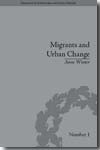Migrants and urban change
- ISBN: 9781851966462
- Editorial: Pickering & Chatto (Publishers) Ltd.
- Fecha de la edición: 2009
- Lugar de la edición: London. Reino Unido
- Colección: Perspectives in Economic and Social History
- Encuadernación: Cartoné
- Medidas: 24 cm
- Nº Pág.: 309
- Idiomas: Inglés

Migration has long been considered an essentially modern phenomenon that only took off during the long nineteenth century when Europe transformed from a largely rural and agricultural society into a highly urbanized and industrialized one. Over the last few decades, research in different areas has led to significant revisions of this powerful image of a one-off rural-urban population transfer. Instead, it is found that population movement was a longer-established tradition, was often a temporary state, and that urban growth was much more reliant on more natural increases in the population.Of paramount importance in this study is the identification of what constitutes continuity and what embodies change, for disentangling the dynamics of migratory patterns demands an understanding of migration as a multi-layered phenomenon, bound up with societal conditions, social relations and individual aspirations. The often local and seasonal migratory patterns of the early modern period would only have been abandoned if they had become untenable.Taking the Belgian city of Antwerp as her case-study, Winter argues that the direction of nineteenth century societal change was such as to make some groups of people better suited to reap the benefits of new opportunities. Between 1760 and 1860 the city underwent a profound transformation from a middle-sized regional textile centre to a booming international port town of more than 120,000 inhabitants. This profound change makes Antwerp an ideal case from which to track the dynamics of migration and Winter uses this to formulate more general insights, leading up to modern-day economic migrations.






